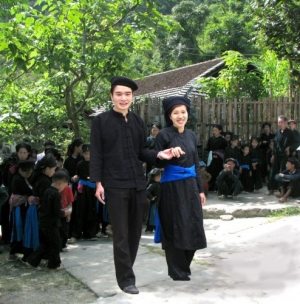MODERN MEETS TRADITION
THE BLANCE BETWEEN THE OLD AND THE NEW ISS ESCPECIALLY EVIDENT AMONG VIETNAM’S ETHNIC MINORITIES IN THE COUNTRY’S REMOSTEST REGIONS
This was my second trip up to the mountains of Ha Giang province. Something about the place struck me the first time I was there and I just had to go back. This time I invited my French friend Atonio Blachez to take a motorbike trip with me.
At the end of wet season the rice terraces of Hoang Su Phi wear green coats as far as the eye can see. This part of the trip, in the southwest of Ha Giang at an elevation of several hundred metres, brought us to somewhere akin to Eden, with singing waterfalls and lush jungle invaded by gaint ferns that took us back to prehistoric times !

Dong Van Karst Park Plateau
The firtile countryside was in contrast to the second part of the trip, which took us over two mountain passes almost 2,000 metres above sea levelto the lunar landscape of the Dong Van National Park. Protected by UNESCO, the Dong Van Karst Park Plateau is well known for erosion giving the rocks in the landspace their characteristic dome-shaped form. We felt the harsh conditions of life at such a high altitude, riding through mist and rain that soaked us to the bone.
Antonie was impressed by he majesty of landscape as well as by various ethnic groups, which include Tay, H’Mong, Lolos, and Nung.
The multi-ethnic character of Vietnam is the most fascinating aspects of the country. Recognised in the Constitution, about 54 ethnic groups live on Vietnamese soil and all benefit from its development.

The Tay people in Ha Giang
“What strikes me most is the adoption of modernity in an ancient life that seems immutable” Antonie said. Each house has a satellite dish. Famers walking to the market in traditional outfits have a mobile phone glued to their ear. Paths and roads are well maintained, most of them paved.
In her book “Globalization and the Integration of Ethnic Minorities in Vietnam” anthropologist Sandrine Basilico use the word “ Viêtcommunication” to describe the process of integration if minorities into the Vietnamese nation “With this concept we mean changes […] inside ethnic minorities, but also within the ethnic majority who gets enriched [..]”
In addition to economic, cultural, educational and health policies of the State, she also emphasises the aspect of trade in goods in a market economy that effects “the culture, the way of life of the minorities with the appearance in the home of modern and westernized objects”
A distinct feature of Vietnam is the respect for traditions, which remain strong despite modernisation that is often desired by minorities themselves.
By chance, we stopped at a village of Tay people where a funeral was taking place. The abundance of offerings, of the paper votive objects, the presence of Taoist shaman, and the solidarity of the villagers to the family of the deceased testify to the permanence of traditional beliefs “The failure comply with them could incur the wrath of the spirits, spirits and ancestors on whole family or village or ethnicity” whote Ms. Balisico.
As sociologist J.Baudrillard demonstrated in his book “The system of Objects”, the possession of new objects are also symbols of a way of life and generate signs of a new culture.
Hence, material transformations induce a cultural change that can be catastrophic for traditional communities under pressure from both economic and media constraints. The concepts of “intangible cultural heritage” is recent and only in 2006 did UNESCO adopt the Convention for the Safeguarding of Intangible Cultural Heritage.
This heritage “include tradition and expressions inherited from our ancestor and passed on to our descendants, such as orals traditions, performing arts, social practices concerning nature and the universe or the knowledge and skills to produce traditional crafts”

Villagers come to help family’s deceased preparation for the funeral
The funeral made me understand the real meaning of statement. The Tay rituals reflect their belief in the cyclical nature of life. The funeral is the largest, most complex, and most expensive. It reflects many elements related to their ancestral cult. It is also desire to free and escort the deceased’s soul to the blissful land. The funeral rite steps are: Anouncing the death, inviting a shaman, shrouding the dead person, establishing the altar, preparing votive offerings, going on a specified diet, carrying out cenemonies (by a Tao) and burial.
The deceased was a father of a family of four girls and a boy. They crafted large effigies in votive paper, like kites, which will follow their father in the afterlife. The number of offerings, such as fruit, cake, alcohol and, especially, sacrificial animals – a buffalo and three pig – express the family’s wealth and importance.

A small house made by bamboo used for covering the coffin
In a procession of ries from mourners and the sounds of haunting gongs shrill flutes, offerings were brought to the altar of the deceased in a tiny room into which all participants gather. The Taoist master then began to chant magical invocations written in Chinese ideograms.

A grave of the Tay people
Intoxicated by the incense-filled air and stunned by the hallucinogenic music, I seemed to be one with the gathered assembly in a mystical fervor. As a photographer, documenting and the authenticity of their culture at the moment reward in itself for undertaking this trip.
Despite the growing global consciousness and the need to preserve intangible heritage, some decisions on the development of Ha Giang province appear completely out of place. In the master of plan for development to 2020, the region wants to build a casino in Dong Van, in the very heart of the national park, simply to attract money and tourists from China !
Defendinh minorities’s right should also be about preserving their culture and soul in the face of globalization.
The Guide






































































































